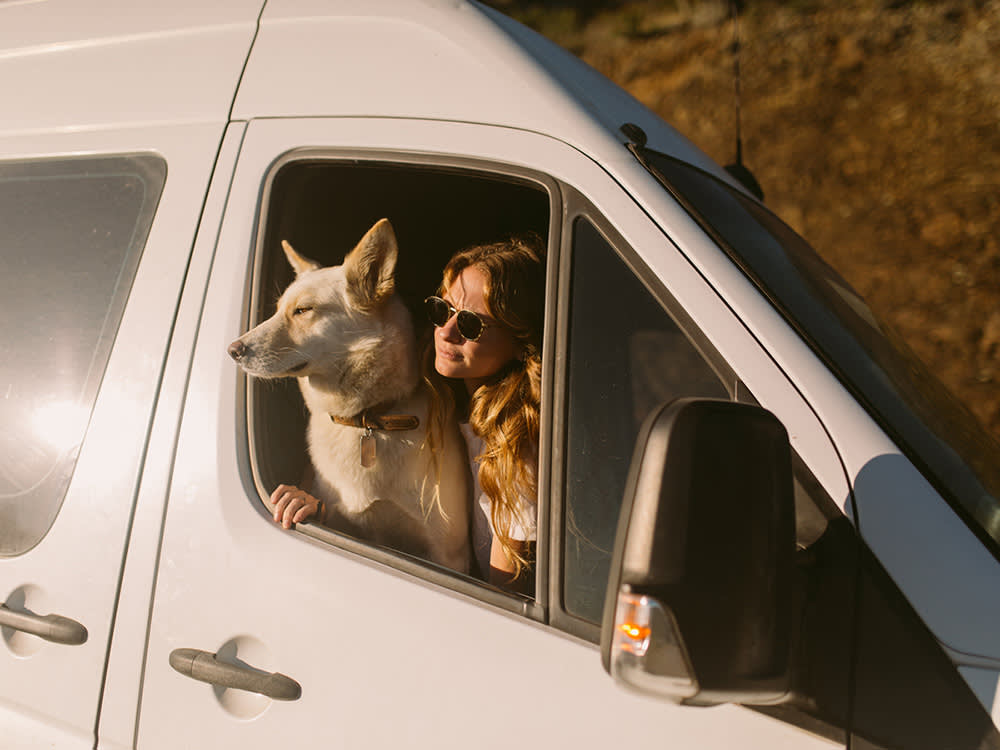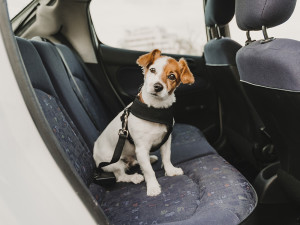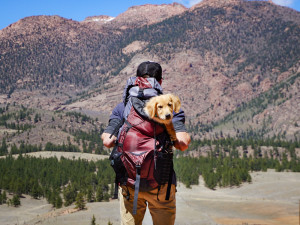How to Road Trip With Your Dog
A dog trainer shares her pro (and personal) #vanlife tips.

Share Article
Taking an extended road trip with your pup can be filled with lifelong memories and tons of social media content, but it’s a different animal than zipping out of town for a short weekend at a pet-friendly cabin. I should know: I took my Golden Retriever on a seven-month, multi-country, four-wheeled adventure a few years back. Let’s just say I learned some things!
First, get real about whether they should come.
This is perhaps the most important decision you’ll make. While it can be loads of fun to share a long trip, it can also be overwhelming for you and your dog. Does your dog get car sick? Spending months on the road is probably not their idea of a good time. Maybe a few long-term rentals are a better option, giving you and your dog a home base with far less time in the car. Do they have aggression challenges with other people or animals? While it’s not impossible to manage behavior on the road, it becomes more difficult. Are they prone to anxiety where such a dramatic change in their routine is likely to cause extreme stress? You will never regret thinking through these things in advance.

Save on the litter with color-changing tech that helps you better care for your cat.
OK, they’re coming! Now, plan your set-up.
While converted vans are the trendiest option for life on the road, there are a lot of ways to see the country and stay comfortable and safe with your dog. I opted for a truck camper and a large pickup truck with a backseat. When we were on the road, Keira had a fancy setup in the backseat so she could chill comfortably and safely. Once we were settled somewhere for the night, we spent our time in the camper, which came equipped with a small kitchen, toilet, bed, and dining table. I opted for a camper without an indoor shower so I’d have more storage for my dog’s things. Sixty square feet is a tight fit, but living minimally and spending most of our time outdoors made it workable.
Research your route.
If your motivation for a road trip is to visit cities and their museums, shows, or other indoor activities, you’ll need to plan where your dog will stay when you do things like that. Maybe you have a friend or family member who can pet sit for a bit, but each time you leave your dog somewhere new, it’s an added stress. Some extroverted dogs are built for this — they can’t wait to meet new people and wouldn’t even notice you were gone for a few hours — but most dogs will feel at least mildly anxious over being with new people and most short-term rentals frown on leaving your dog alone. If you have a breed of dog that is traditionally discriminated against, you’ll have an additional barrier as many short-term rentals and campgrounds still prohibit certain dogs.
An outdoor-centered trip is typically easier on everyone. In seven months, Keira and I visited over 30 national parks and forests in the U.S. and Canada and broke up the trip by visiting family and friends along the way. If you focus your trip around state and national parks, be sure to check regulations. Some parks, like the Badlands in South Dakota, don’t allow dogs on many of the trails, while others, like Death Valley, are famously too hot for dogs to enjoy.
In both parks, I made sure to arrive early to get a site with electricity (and therefore, air conditioning) and then made friends with our RV neighbors who offered to check in on Keira while I was hiking. Travelers are often missing their own pets and will jump at the opportunity to spend time with your dog. If the campsites were full or I couldn’t find anyone to keep an eye on her, I was prepared to keep driving until I found a safer place for us.
Prep your dog.
Talk with your veterinarian to ensure your dog is up to date on all appropriate vaccinations and plan to print out your dog’s records, including their rabies certificate, which will be required if you need to use a boarding facility or to enter another country. Depending on where you plan to travel, there may be a need to protect them from diseases that are rare in your hometown but more prevalent in the places you’re visiting.
If you need to cross the border into Canada or Mexico, be sure to check international rules, which may include a health certificate issued within a week or two of your arrival – a tricky requirement if you’re many miles away from your regular veterinarian. As for all the various pet gear you’ll need: Before the big trip, take a few test runs with your dog, perhaps driving to a nearby campground to practice setting up and to see if you forgot to pack any important supplies.
Finally, have a backup plan.
You’ve planned your setup, your tentative route, and prepared your dog, but you won’t really know how your dog will take things till you’re on the road. Plan ahead by asking a family member or friend if they’d be willing to care for your pup in the event things aren’t going well and save some extra funds to help offset potential petsitting costs. Rethinking your route and allowing for longer stays in fewer places may also be a solution. When I first set out, I planned to spend a year on the road but by late fall, it was becoming increasingly uncomfortable to sleep in the truck camper, so I headed home, where Keira and I spent the last three months of our sabbatical napping, eating, and hiking while I prepared to re-enter the workforce.
Living on the road can be a life-changing experience. By putting together a solid game plan, you can ensure your days are filled with more tail wags and fewer barks.

Lindsay Hamrick, CPDT-KA
Lindsay Hamrick lives in New Hampshire with her three dogs, chickens, and an assortment of rotating foster animals. She forces her elderly chihuahua, Grandma Baguette, on overnight backpacking trips, can diaper a lamb with one hand, and while she’s a long-time Certified Professional Dog Trainer, 66.7% of her dogs still won’t lay down when asked.

